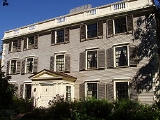
Hooper-Lee-Nichols House
Encyclopedia
The Hooper-Lee-Nichols House is a historic Colonial America
n house in Cambridge, Massachusetts
. Initially constructed 1685 and enlarged and remodeled many times thereafter, it is located at 159 Brattle Street in Cambridge. It is the second-oldest house in the city (after the Cooper-Frost-Austin House
, c. 1681-1682). The house is now headquarters for the Cambridge Historical Society, which provides tours are several times a week.
Judge Joseph Lee bought the house in 1758, adding the enclosed entry porch and applying stucco to the west wall. Lee was a British Loyalist and hence vacated his house during the first days of the American Revolution
; he returned however in 1777.
In 1850, George and Susan Nichols rented and began to renovate the house. They enlarged the rear and installed the roof balustrade, containing balusters once part of the chancel of Saint Paul's Cathedral in Boston
. In 1916 their grandson raised the rear of the house to a full three stories. Finally in 1923 William and Frances Emerson purchased the house. He was for many years Dean of Architecture at MIT; and she deeded the house to the Cambridge Historical Society which came into its possession in 1957. In the early 1980s, the Society made extensive exterior restorations.
The house is open for tours on Tuesdays and Thursdays at 2 and 3 PM.
Colonial America
The colonial history of the United States covers the history from the start of European settlement and especially the history of the thirteen colonies of Britain until they declared independence in 1776. In the late 16th century, England, France, Spain and the Netherlands launched major...
n house in Cambridge, Massachusetts
Cambridge, Massachusetts
Cambridge is a city in Middlesex County, Massachusetts, United States, in the Greater Boston area. It was named in honor of the University of Cambridge in England, an important center of the Puritan theology embraced by the town's founders. Cambridge is home to two of the world's most prominent...
. Initially constructed 1685 and enlarged and remodeled many times thereafter, it is located at 159 Brattle Street in Cambridge. It is the second-oldest house in the city (after the Cooper-Frost-Austin House
Cooper-Frost-Austin House
The Cooper-Frost-Austin House is a historic Colonial American house, currently estimated to have been constructed circa 1681-1682. It is located at 21 Linnaean Street, Cambridge, Massachusetts. It is the oldest extant home in Cambridge and operated as a non-profit museum by Historic New England...
, c. 1681-1682). The house is now headquarters for the Cambridge Historical Society, which provides tours are several times a week.
History
The house was originally built in 1685 by Dr. Richard Hooper as a typical "first-period" farmhouse, although its ceilings were plastered, which was unusual for a modest house. When Hooper died in 1691, his wife took in boarders and the property then began fall into disrepair. She in turn died in 1701, and the house continued its decline until 1717, when it was inherited by Hooper's son, Dr. Henry Hooper. He added a lean-to and rebuilt the chimney with cooking ovens. In 1733, he sold the house to Cornelius Waldo, who added a third story and wooden quoins at the house's corners. Waldo also installed larger windows. The result was a house that looked thoroughly Georgian.Judge Joseph Lee bought the house in 1758, adding the enclosed entry porch and applying stucco to the west wall. Lee was a British Loyalist and hence vacated his house during the first days of the American Revolution
American Revolution
The American Revolution was the political upheaval during the last half of the 18th century in which thirteen colonies in North America joined together to break free from the British Empire, combining to become the United States of America...
; he returned however in 1777.
In 1850, George and Susan Nichols rented and began to renovate the house. They enlarged the rear and installed the roof balustrade, containing balusters once part of the chancel of Saint Paul's Cathedral in Boston
Boston
Boston is the capital of and largest city in Massachusetts, and is one of the oldest cities in the United States. The largest city in New England, Boston is regarded as the unofficial "Capital of New England" for its economic and cultural impact on the entire New England region. The city proper had...
. In 1916 their grandson raised the rear of the house to a full three stories. Finally in 1923 William and Frances Emerson purchased the house. He was for many years Dean of Architecture at MIT; and she deeded the house to the Cambridge Historical Society which came into its possession in 1957. In the early 1980s, the Society made extensive exterior restorations.
The house is open for tours on Tuesdays and Thursdays at 2 and 3 PM.

